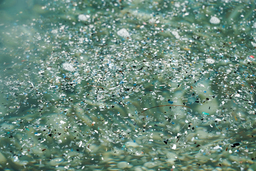Microplastic Removal using Adhesives
TECHNOLOGY NUMBER: 2020-195

OVERVIEW
Passive system for capture and removal of microplastics in water- Adhesive coating for any form factor
- Effective for many types of microplastics
BACKGROUND
Microplastics are small plastic particles less than 5 millimeters in size that come from various sources, including the breakdown of larger plastic items like bottles and bags, as well as from microbeads in personal care products, synthetic fibers from textiles, and industrial processes. Microplastics are now ubiquitous in the environment and are found in all surface water, including locations as remote as the Arctic and the deepest parts of the ocean. Microplastics have been found in various human consumables, including seafood, salt, and drinking water. While the health effects of ingesting microplastics are still being studied, there are concerns about potential risks, including inflammation, cellular damage, and the transfer of harmful chemicals. While efforts to remove large plastic items from the environment have been ongoing, comparatively little has been done to address microplastics pollution. So, a need exists for new technologies that help to mitigate the presence of microplastics in the environment.
INNOVATION
Researchers at the University of Michigan have identified adhesives that remove microplastics from aqueous solutions. Surfaces coated with the adhesive have been shown to rapidly adhere microplastics suspended in water upon contact. Insertion of an adhesive-coated object into the solution followed by extraction presents a successful approach to concentrating and removing microparticles from the solution. The adhesives have been shown to work with a variety of microplastics, including polystyrene, nylon, and rubber. As an additional environmental benefit, the adhesive used for microplastics removal may be produced using an open-loop recycling process that converts waste super-absorbent polymers into pressure sensitive adhesives. This process therefore provides a scalable, low CO2 emissions route to convert waste polymers from diapers and feminine hygiene products into adhesives that effectively capture microplastics in water.